AUDI ALLROAD 2000 Owners Manual
Manufacturer: AUDI, Model Year: 2000, Model line: ALLROAD, Model: AUDI ALLROAD 2000Pages: 306, PDF Size: 9.95 MB
Page 211 of 306
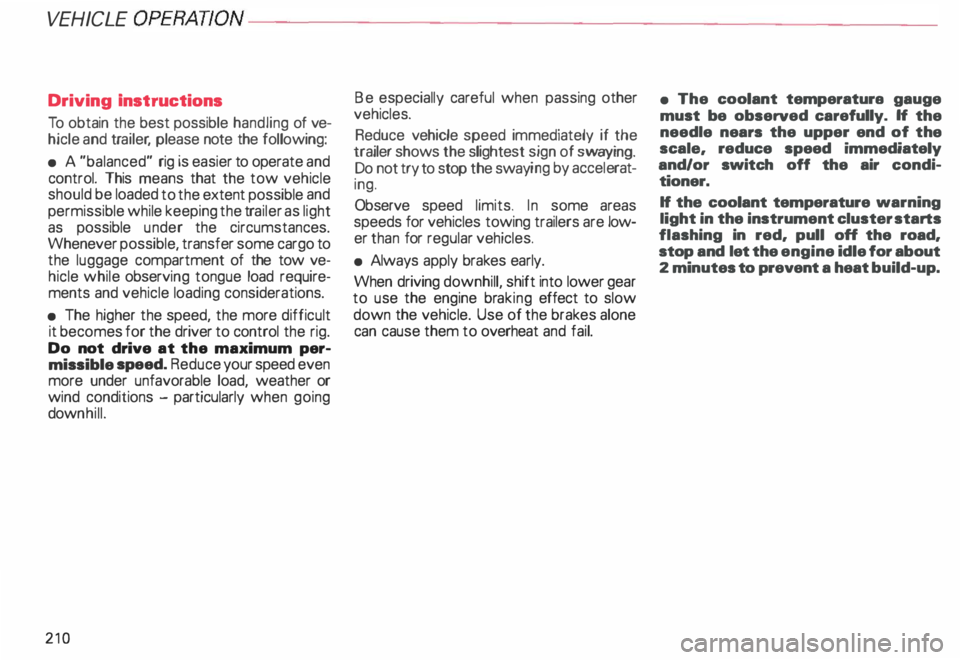
VEHICLE OPER
ATION-----------------------
Driving Instructions
To obtain the best possible handling of ve
hicle and trailer , please note the following:
• A "balanced" rig is easier to operate and
control. This means that the tow vehicle
should be loaded to the extent possible and
permissible while keeping the trailer as light
as possible under the circumstances.
Whenever possible, transfer some cargo to
the luggage compartment of the tow ve
hicle while observing tongue load require
ments and vehicle loading considerations.
• The higher the speed, the more difficult
it becomes for the driver to control the rig.
Do not drive at the maximum per
missible speed. Reduce your speed even
more under unfavorable load, weather or
wind conditions - particularly when going
dow nhill.
210 Be
especially careful when passing other
vehicles.
Reduce vehicle speed immediately if the
trailer shows the slightest sign of swaying.
Do not try to stop the sway ing by accel erat
ing.
Observe speed limits. In some areas
speeds for vehicles towing trailers are low
er than for regular vehicles.
• Always apply brakes early.
When driving downhill, shift into lower gear
to use the engine braking effect to slow
down the vehicle. Use of the brakes alone
can cause them to overheat and fail. •
The coolant temperatura gauge
must be observed carefully. H the
needle nears the upper end of the
scale, reduce speed immediately
and/or switch off the air condi
tioner.
If the coolant temperature warning
light in the instrument cluster starts
flashing in red, pull off the road,
stop and let the engine idle for about
2 minutes to prevent a heat build-up.
Page 212 of 306
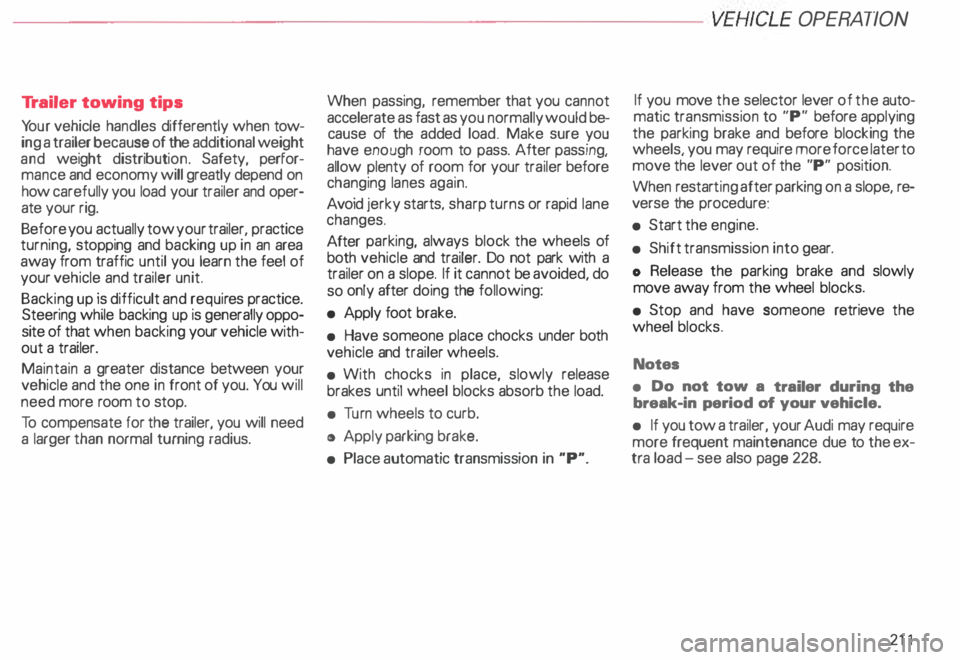
-----------------------VEHICL E OPER ATION
Tr ailer towing tips
Yo ur vehicle handles differently when tow
ing a trailer because of the additional weight
and weight distribution. Safety, perfor
mance and economy will greatly depend on
how carefully you load your trailer and oper
ate your rig.
Before you actually tow your trailer, practice
turning, stopping and backing up in an area
away from traffic until you learn the feel of
your vehicle and trailer unit.
Backing up is difficult and requir es practice.
Steering while backing up is generally oppo
site of that when backing your vehicle with
out a trailer.
Maintain a greater distance between your
vehicle and the one in front of you. You will
need more room to stop.
To compensate for the trailer, you will need
a larger than normal turning radius. When
passing, remember that you cannot
accelerate as fast as you normally would be
cause of the added load. Make sure you
have enough room to pass. After passing,
allow plenty of room for your trailer before
changing lanes again.
Avoid jerky starts, sharp turns or rapid lane
changes.
After parking, always block the wheels of
both vehicle and trailer. Do not park with a
trailer on a slope. If it cannot be avoided, do
so only after doing the following:
• Apply foot brake.
• Have someone place chocks under both
vehicle and trailer wheels.
• With chocks in place, slowly release
brakes until wheel blocks absorb the load.
• Turn wheels to curb.
o Apply parking brake.
• Place automatic transmission in "P". If
you move the selector lever of the auto
matic transmission to "P" before applying
the parking brake and before blocking the
wheels, you may require more force later to
move the lever out of the "P" position.
When restarting after parking on a slope, re
verse the procedure:
• Start the engine.
• Shift transmission into gear.
o Release the parking brake and slowly
move away from the wheel blocks.
• Stop and have someone retrieve the
wheel blocks.
Notes
• Do not tow a trailer during the
break-in period of your vehicle.
• If you tow a trailer, your Audi may require
more frequent maintenance due to the ex
tra load -see also page 228.
211
Page 213 of 306
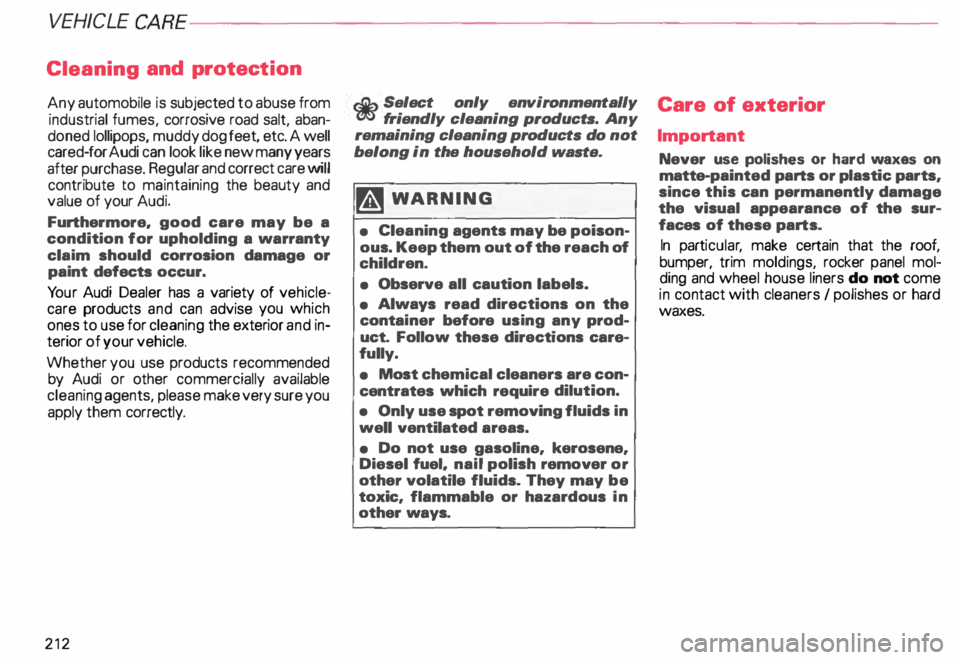
VEHICLE CA
RE---------------------------------------------------
Cleaning and protec tion
Any automobile is subjected to abuse from
indus trial fumes, corrosive road salt, aban
doned lollipops, muddy dog feet, etc. A well
cared- for Audi can look like new many years
after purchase. Regular and correct care will
contribute to maintaining the beauty and
value of your Audi.
Furthermore. good care may be a
condition for upholding a warranty
claim should corrosion damage or
paint defects occur.
Yo ur Audi Dealer has a variety of vehicle
care products and can advise you which
ones to use for cleaning the exterior and in
terior of your vehicle.
Whether you use products recommended
by Audi or other commercially available
cleaning agents, please make very sure you
apply them correctly.
212
r.Gb Select only environmentally � friendly cleaning products. Any
remaining cleaning products do not
belong in the household waste.
�W ARNING
• Cleaning agents may be poison
ous. Keep them out of the reach of
children.
• Observe all caution labels.
• Always read directions on the
cont ainer before using any prod
uct. Follow these directions care
fully.
• Most chemical cleaners are con
centrates which require dilution.
• Only use spot removing fluids in
well ventilated areas.
• Do not use gasoline. kerosene.
Diesel fuel. nail polish remover or
other volatile fluids. They may be
toxic, flammable or hazardous in
other ways. Care
of exterior
Important Never use polishes or hard waxes on
matte- painted parts or plastic parts,
since this can permanently damage
the visual appearance of the sur
faces of these parts.
In parti cular , make certain that the roof,
bumper, trim moldings, rocker panel mol
ding and wheel house liners do not come
in contact with cleaners I polishes or hard
waxes.
Page 214 of 306
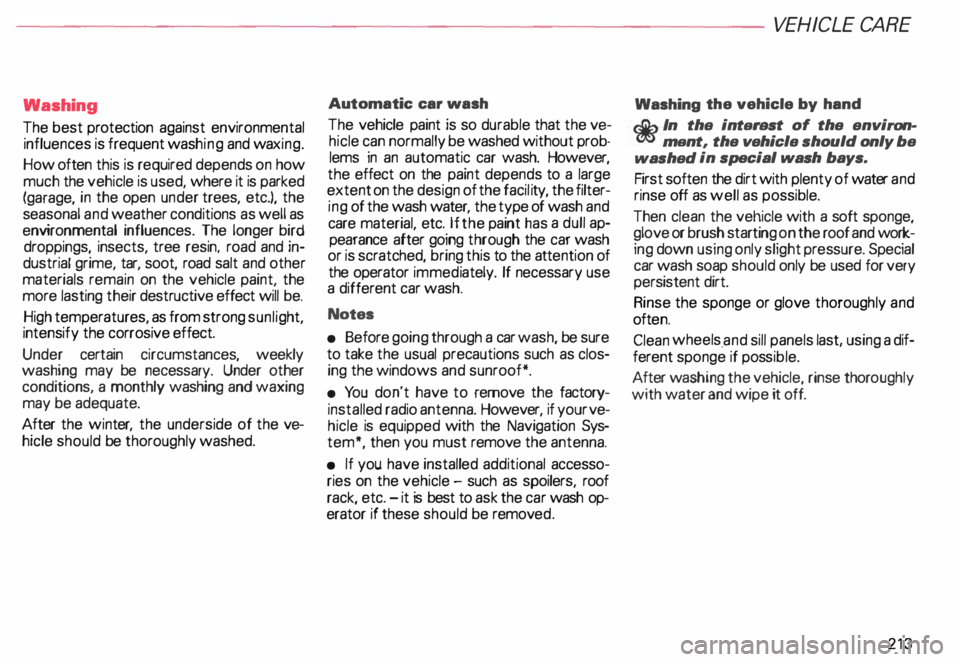
Washing
The best protection against environmental
influences is frequent washing and waxing.
How often this is required depends on how
much the vehicle is used, where it is parked
(garage, in the open under trees, etc.), the
seasonal and weather conditions as well as
env ironmental influences. The longer bird
droppings, insects, tree resin, road and in
dustrial grime, tar, soot, road salt and other
materials remain on the vehicle paint, the
more lasting their destructive effect will be.
High temperatures, as from strong sunlight,
intensify the corrosive effect.
Under certain circumstances, weekly
washing may be necessary. Under other
conditions. a monthly washing and waxing
may be adequate.
After the winter, the underside of the ve
hicle should be thoroughly washed. Automatic
car wash
The vehicle paint is so durable that the ve
hicle can normally be washed without prob
lems in an automatic car wash. However,
the effect on the paint depends to a large
extent on the design of the facil ity, the filter
ing of the wash water, the type of wash and
care material, etc. If the paint has a dull ap
pearance after going through the car wash
or is scratched, bring this to the atte ntion of
the operator immediately. If necessary use
a different car wash.
Notes
• Before going through a car wash, be sure
to take the usual precautions such as clos
ing the windows and sunroof*.
• You don't have to remove the factory
installed radio antenna. However, if your ve
hicle is equipped with the Navigation Sys
tem*, then you must remove the antenna.
• If you have installed additional accesso
ries on the vehicle -such as spoilers, roof
rack, etc. -it is best to ask the car wash op
erator if these should be remov ed. VE
HICLE CARE
Washing the vehicle by hand
� In the intsi'Sst of the environ
� msnt, the vehicle should only be
washed in special wash bays.
First soften the dirt with plenty of water and
rinse off as well as possible.
Then clean the vehicle with a soft sponge,
glove or brush starting on the roof and work
ing down using only slight pressure. Special
car wash soap should only be used for very
persistent dirt.
Rinse the sponge or glove thoroughly and
oft en.
Clean wheels .and sill panels last, using a dif
ferent sponge if pos sible.
After washing the vehicle, rinse thoroughly
with water and wipe it off.
213
Page 215 of 306
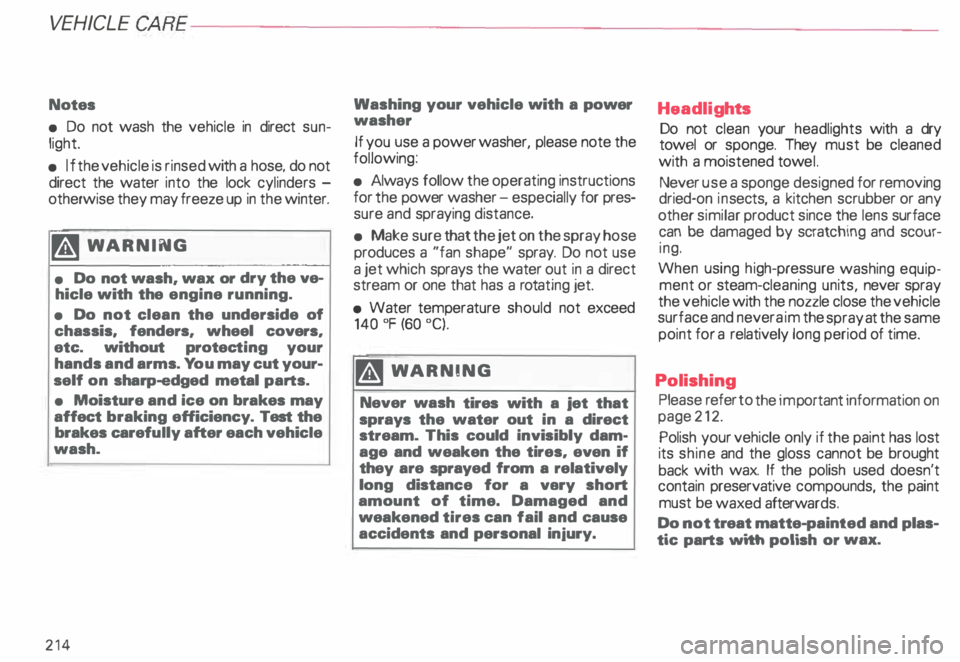
VEHICL E CA
RE----------------------------------------------------
Notes
• Do not wash the vehicle in direct sun
light.
• If the vehicle is rinsed with a hose, do not
direct the water into the lock cylinders -
otherwise they may freeze up in the winter.
�W ARNING
• Do not wash, wax or dry the ve
hicle with the engine running.
• Do not clean the underside of
chassis, fenders, wheel covers,
etc. without protecting your
hands and arms. You may cut your
self on sharp-edged metal parts.
• Moisture and ice on brakes may
affect braking efficiency. Test the
brakes carefully after each vehicle
wash.
214 Washing
your vehicle with a power
washer
If you use a power washer, please note the
following:
• Always follow the operating instructions
for the power washer -especially for pres
sure and spraying distance.
• Make sure that the jet on the spray hose
produces a "fan shape" spray. Do not use
a jet which sprays the water out in a direct
stream or one that has a rota ting jet.
• Water temperature should not exceed
140 °F (60 °C).
�W ARNING
Never wash tires with a jet that
sprays the water out in a direct
stream. This could invisibly dam
age and weaken the tires, even if
they are sprayed from a relatively
long distance for a vary short
amount of time. Damaged and
weakened tires can fail and cause
accidents and personal injury. Headli
ghts
Do not clean your headlights with a dry
towel or sponge. They must be cleaned
with a moistened towel.
Never use a sponge designed for removing
dried-on insects, a kitchen scrubber or any
other similar product since the lens surface
can be damaged by scrat ching and scour
ing.
When using high-pressure washing equip
ment or steam-cl eaning units, never spray
the vehicle with the nozzle close the vehicle
surface and never aim the spray at the same
point for a relatively long period of time.
Polishing Please refer to the imp ortant information on
page 212.
Polish your vehicle only if the paint has lost
its shine and the gloss cannot be brought
back with wax. If the polish used doesn't
contain preservative compounds, the paint
must be waxed afterwards.
Do not treat matte- pain�ed and plas
tic parts with polish or wax.
Page 216 of 306
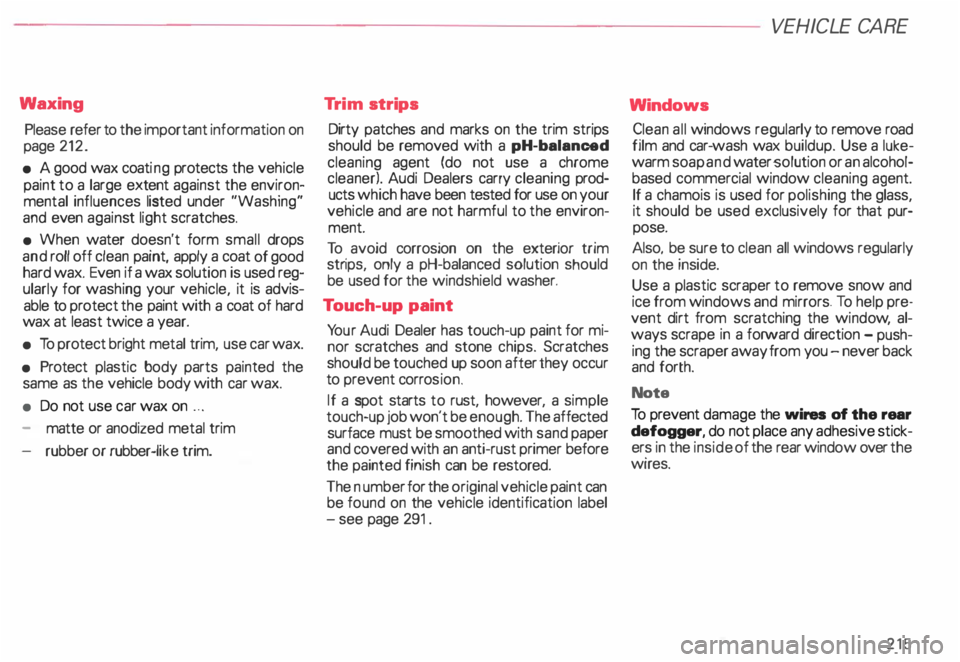
Waxing
Please refer to the important information on
page 212.
• A good wax coati ng protects the vehicle
paint to a large extent against the environ
mental influences listed under "Washing"
and even agains t light scratches.
• When water doesn't form small drops
and roll off clean paint, apply a coat of good
hard wax. Even if a wax solution is used reg
ularly for washing your vehicle, it is advis
able to protect the paint with a coat of hard
wax at least twice a year.
• To protect bright metal trim, use car wax.
• Protect plastic body parts painted the
same as the vehicle body with car wax.
• Do not use car wax on ...
- matte or anodized metal trim
rubber or rubber-l ike trim. Tr
im strips
Dirty patches and marks on the trim strips
should be removed with a pH-balanced
cleaning agent (do not use a chrome
cleaner). Audi Dealers carry cleaning prod
ucts which have been tested for use on your
vehicle and are not harmful to the environ
ment.
To avoid corrosion on the exterior trim
str ips, only a pH-balanced solution should
be used for the windshield washer.
To uch-up paint
Yo ur Audi Dealer has touch-up paint for mi
nor scratches and stone chips. Scratches
should be touched up soon after they occur
to prevent corrosion.
If a spot starts to rust, however, a simple
touch-up job won't be enough. The affected
surface must be smoothed with sand paper
and covered with an anti-rust primer before
the painted finish can be restored.
The n umber for the original vehicle paint can
be found on the vehicle identification label
- see page 291 . VE
HICLE CARE
Windows Clean all windows regularly to remove road
film and car- wash wax buildup. Use a luke
warm soap and water sol uti on or an alcohol
based commercial window cleaning agent.
If a chamois is used for polishing the glass,
it should be used exclusively for that pur
pose.
Also, be sure to clean all windows regularly
on the inside.
Use a plastic scraper to remove snow and
ice from windows and mirrors. To help pre
vent dirt from scratching the windo w, al
ways scrape in a forward direction -push
ing the scraper away from you-never back
and forth.
Note
To prevent damage the wires of the rear
defogger, do not place any adhesive stick
ers in the inside of the rear window over the
wires.
215
Page 217 of 306
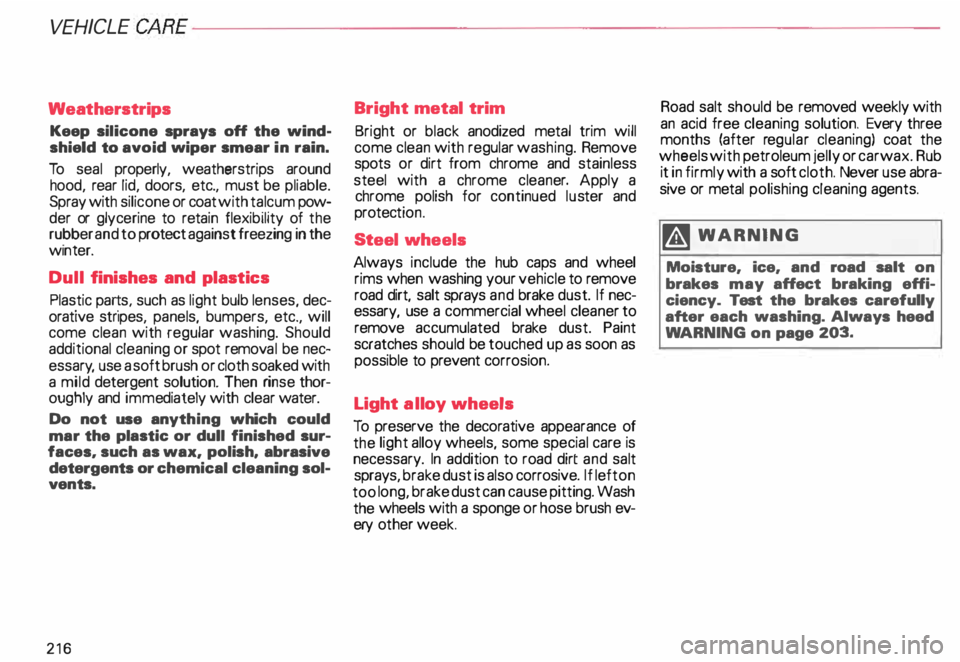
VEHICL E
CA RE-------------------------
Weatherstrips
Keep silicone sprays off the wind
shield to avoid wiper smear in rain.
To seal properly, weatherstrips around
hood, rear lid, doors, etc., must be pliable.
Spray with silicone or coat with talcum pow
der or glycerine to reta in flexibility of the
rubber and to protect against freezing in the
w1nter.
Dull finishes and plastics
Plas .tic pa �s. such as light bulb lenses, dec
orative stnpes, panels, bumpers, etc., will
come clean with regular washing. Should
additional cleaning or spot remova l be nec
essar y, use a soft brush or cloth soaked with
a mild detergent solution. Then rinse thor
oughly and imme diately with clear water.
Do not use anyth ing which could
mar the plastic or dull finished sur
faces, such as wax, polish, abrasive
detergents or chemical cleaning sol
vents.
216 Bright
metal trim
Bright or black anodized metal trim will
come clean with regular washing. Remove
spots or dirt from chrome and stainless
steel with a chrome cleaner. Apply a
chrome polish for continued luster and
protec tion.
Steel wheels
Always include the hub caps and wheel
rims when washing your vehicle to remove
road dirt, salt sprays and brake dust. If nec
essary, use a commercial wheel cleaner to
remove accumulated brake dust. Paint
scratches should be touched up as soon as
possible to prevent corrosion.
Light alloy wheels
To preserve the decorative appearance of
the light alloy wheels, some special care is
necessary. In addition to road dirt and salt
sprays, brake dust is also corrosive. If left on
too long, brake dust can cause pitting. Wash
the wheels with a sponge or hose brush ev
ery other week. Road salt
should be removed weekly with
an acid free cleaning solution. Every three
months (after regular cleaning) coat the
wheels with petroleum jelly or car wax. Rub
it in firmly with a soft cloth. Never use abra
sive or metal polishing cleaning agents.
� WARNING
Moisture, ice, and road salt on
brakes may affect braking effi
ciency. Test the brakes carefully
after each washing. Always heed
WA RNING on page 203.
Page 218 of 306
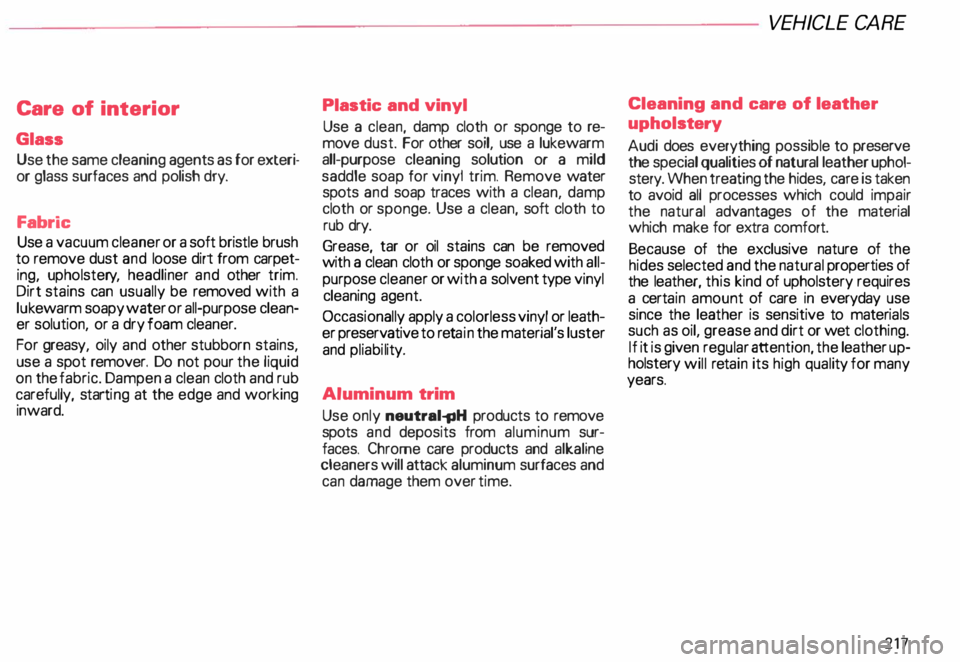
Care
of interior
Glass Use the same cleaning agents as for exteri
or glass surfaces and polish dry.
Fabric Use a vacuum cleaner or a soft bristle brush
to remove dust and loose dirt from carpet
ing, upholste ry, headliner and other trim.
Dirt stains can usually be removed with a
lukewarm soapy water or all-purpose clean
er solution, or a dry foam cleaner.
For greasy, oily and other stubborn stains,
use a spot remover. Do not pour the liquid
on the fabric. Dampen a clean cloth and rub
carefully, starting at the edge and working
inward. Plastic
and vinyl
Use a clean, damp cloth or sponge to re
move dust. For other soil, use a lukewarm
all-purpose cleaning solution or a mild
saddle soap for vinyl trim. Remove water
spots and soap traces with a clean, damp
cloth or sponge. Use a clean, soft cloth to
rub dry.
Grease, tar or oil stains can be removed
with a clean cloth or sponge soaked with all
purpose cleaner or with a solvent type vinyl
cleaning agent.
Occasionally apply a colorless vinyl or leath
er preservative to reta in the material's luster
and pliabi lity.
Aluminum trim
Use only neutral-pH products to remove
spots and deposits from aluminum sur
faces. Chrome care products and alkaline
cleaners will atta ck aluminum surfaces and
can damage them over time. VEH
ICLE CA RE
Cleaning and care of leather
uphols tery
Audi does everything possible to preserve
the special qualities of natural leather uphol
stery. When treating the hides, care is taken
to avoid all processes which could impair
the natural advantages of the material
which make for extra comfort.
Because of the exclusive nature of the
hides selected and the natural properties of
the leather, this kind of upholstery requires
a cert ain amount of care in everyday use
since the leather is sensitive to mater ials
such as oil, grease and dirt or wet clothing.
If it is given regular attention, the leather up
holstery will retain its high quality for many
years.
217
Page 219 of 306

VE
HICL E CA
RE-------------------------
Dust and small particles of dirt lodging in the
pores, grain and seams can have an abra
sive effect and damage the surface and the
seams. If the vehicle is left standing for a
long time in the sun, cover the upholstery or
use the sun blinds to protect the leather
from direct sunlight and prevent fading or
discoloration.
Depending on the amount of use, clean it
occasionally according to the following
instructions. Never use solvents, wax
polish, shoe cream, spot removers
or similar materials.
For normal cleaning of leather -covered
steering wheels, leather seat upholstery,
etc., slightly moisten a cotton or woollen
cloth with water and wipe over the areas af
fected.
218 More
stubborn dirt can be removed using a
mild soap solution (pure liquid soap: two
tablespoons dissolved in 1 quart of water).
It is very important not to let the wa
ter soak through the leather or pene
trate into the seams. Then wipe off with
a soft, dry cloth.
In addition to this regular cleaning, it is
worth while treating the leather with a suit
able leather -care product. This should be
done about twice a year for uphol stery in
normal use. Apply these products very spar
ingly and follow the manufacturer's direc
tions.
Safety belts
Keep belts clean! Dirty belts may
not retract properly.
For cleaning, use a mild soap and water
solution. Let belts dry thoroughly and away
from direct sunlight.
Do not allow inertia reel safety belts to re
tract before they are completely dry. �W
ARNING
• Any thing that might damage
your safety balta could mean that
you and your passengers would
not be adequately protected in an
accident.
• Do not use chemical cleaning
agents, bleach or dyes. They have
corrosive properties which weak
en the webbing.
• When cleaning your safety
belts, inspect them for damage. If
you discover damage. see your
Audi Dealer.
• Safety belt performance de
pends on correct installation.
Never remove belts from the ve
hicle to clean them.
Page 220 of 306

-------------------------VEHICLE CA
RE
Engine compartment
�W ARNING
• Before working in the engine
compartment. be sure to read the
information on page 232.
I) Before reaching into the front
plenum panel. always re!"ove the
ignition key. Otherw1se. the
windshield wiper system could
unin tentionally be switched on.
possibly causing personal injury
from the moving wiper linkage.
• Do not wash. wax or dry the en�
gine with the engine ru!'l'! ing. Mov
ing or hot parts could 1n1ure you. ,Al
WARNING continued
e Do not clean the underside of
the chassis, fenders. wheel cov
ers. or other hard to reach parts
without protecting your hands and
arms. You may cut yourself on
sharp-edged metal parts.
• Moisture and ice on brakes may
affect braking efficiency. Test the
brakes carefully after each vehicle
wash.
The engine compartment and transmission
have been corrosion protected at the facto
ry.
Remove leaves from the plenum panel in
front of the windshield under the engine
hood. This prevents the water drain holes
from becoming blocked, and it prevents de
bris from entering the vehicle interior
throug h the heating and ventilation ducts. Good
anti-corrosion treatment is very im
porta nt, particularly in the winter. If the ve
hicle is frequently driven on salted roads,
the entire engine compartment and plenum
panel should be thor oughly cleaned at the
end of winter and retreated to prevent salt
damage. At the same time, the underside of
the vehicle should be washed as well.
�W ARNING
Never touch the radiator fan. The
auxiliary electric fan can switch on
suddenly and injure you-
Always switch off the ignition be
fore cleaning the engine _
219